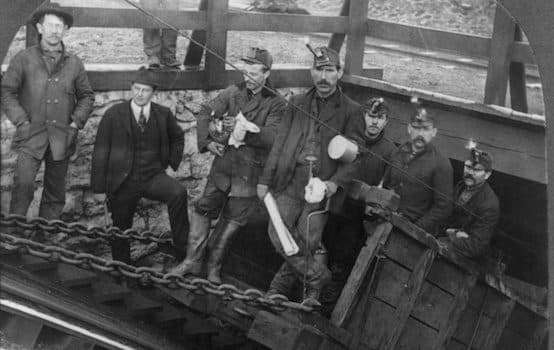
The End of Outrage, Breandan Mac Suibhne, Oxford University Press, 320 pages
What is the Irish Catholic experience? This question is harder to answer in an age of acceleration and fragmentation. After all, filtered photos, snaps, and Twitter characters dictate countless daily lives. A pixelated existence cannot accommodate attention to oral histories, familial traditions, and religious customs. The dispersing of Irish Catholic hamlets to suburbia, accompanied by the closure or demographic change of parishes, has further erased remnants of this once identifiable cultural tribe.
For those endowed with repositories of childhood memories, to be Irish Catholic, at least in America, is to absorb and accept certain practices and mannerisms. It is to weather the biting wit that checks pride or folly, to receive left-handed compliments from unimpressed relatives, and to obey the sanctity of multi-generational grudges.
To be Irish Catholic is to remember those who suppress scandalous stories, sympathize with the downtrodden, and nurse a quiet suspicion of success. It is to witness the peculiar dynamics of an officious mother and her bachelor son. It is to bear the scars of Catholicism while also finding consolation in its saints and prayers. And it is to nurture a primordial melancholy, either finding comfort in sadness or forgoing sobriety to numb the pain. Alcohol is inescapably a part of this DNA, as the Irish-American journalist Pete Hamill wrote in his memoir. “The culture of drink endures because it offers so many rewards: confidence for the shy, clarity for the uncertain, solace to the wounded and lonely, and above all, the elusive promises of friendship and love.”
Millennials will likely be the last generation to fully comprehend such tribal qualities. The Irish Catholic experience peaked during the Second Vatican Council, but has slowly faded with the death of older relatives, the changed cultural makeup of urban neighborhoods, the dissolution of cash-strapped and scandal-ridden parishes, and an overall indifference towards tradition in this modern era.
Irish Millennials can still point out the Sacred Heart and the Infant of Prague in their grandparents’ homes, recall the meaning of Forty Hours’ Devotion, and recite rebel songs played at parish festivals. As children, they heard U2, The Cranberries, and The Corrs on the radio, perhaps inspiring curiosity about their heritage. But as adults, many Millennials have come to believe that ancestral appreciation is just another contemporary casualty, one that can be digitally embalmed by Google. For this isn’t the first time that the Irish have “exchange[d] themselves for the future,” as Breandan Mac Suibhne reminds us.
♦♦♦
Mac Suibhne’s book, The End of Outrage, studies the Irish habit of ambivalently accepting the present while willfully forgetting the past. In America, the Irish nurtured a post-Famine identity for over a century. Immigrants arrived in steel, mining, and factory towns where they preserved elements of their culture through parishes, fraternal organizations, and saloons.
Subsequent generations inherited these social bonds. They embraced their heritage while also fostering the perception of an Ireland frozen in the past. In the mid-1800s, many Irish arrivals purged their previous lives of sorrow, shame, and heartbreak. This left their descendants with distorted ideas of a land unchanged by time. Mac Suibhne, well versed in this transatlantic catharsis, investigates the haunting silence that enveloped Irish Catholicism in one isolated part of Ireland. Through a panoramic exploration of County Donegal, he recounts how rural Ireland adjusted after the Potato Famine in the 1840s.
A Centenary College historian and National Endowment for the Humanities fellow, Mac Suibhne paints an evocative canvas of clashing tribes and morally opaque characters. He resurrects Donegal as it existed in the 19th century—a self-contained region confronting change and loss in a rapidly industrializing world.
Donegal is located in northwest Ulster, a culturally orphaned and geographically remote region endowed with dramatic landscapes. The county’s rugged coastlines, daunting mountains, and lush valleys remain almost unnaturally beautiful. Donegal’s geological composition perpetuates a sense of the mystical between its people and their land.
It’s from here that Mac Suibhne hails. He charts post-Famine adjustment in his birthplace, Beagh, a small community in southwest Donegal. This townland was settled long before the Famine, when families subsisted on oats and lived on land unsuitable for cultivation. In the mid-19th century, the region was “steeped to the lips in poverty,” with class division, mass starvation, merciless landlords, and an oppressive English regime creating unrest. Such conditions incited violence from a secret society, their acts of “outrage” serving as the basis for Mac Suibhne’s study.
This enigmatic and oath-bound society, the Molly Maguires, followed a tradition in Ireland’s countryside. In the 1840s, the Molly Maguires were the latest retributive group following a succession of rural societies like the Whiteboys and Ribbonmen. The Molly Maguires were especially prevalent in Donegal, where they committed disruptive or violent acts against tenants, farmers, landlords, and authority figures.
While the Mollies’ conduct is widely documented, the origin of their name remains a mystery. Stories range from an evicted old widow named Molly Maguire to the practice of mummery, with men dressed in costume or disguised as women. Regardless, this agrarian practice pervaded west Donegal, with Mollies intimidating those who evicted tenants, mistreated the elderly, or overcharged the poor. The Mollies’ presence paralleled Donegal’s transition from communal farms to squared agriculture. The “squaring” of farms particularly transformed the countryside, forcing families to fend for themselves in a region often grappling with poverty, oppression, hunger, disease, and death.
But Donegal’s struggles persisted regardless of the Famine. The county, especially in the west, escaped the worst of the potato blight and ended up having the ninth lowest mortality rate in Ireland. Mac Suibhne explains that the impoverished class, accustomed to weather-related crop failures and support from relief agencies, were better prepared when the Famine peaked and food prices soared in the late 1840s. When the Famine ended, Molly Maguire activity slowly declined in west Donegal. Mac Suibhne recounts that following the hunger, “tensions emerged in the Molly Maguires when one element sought to curtail such activity, while another sought, unsuccessfully, to expand it.”
But the Mollies remained active in Beagh, where they targeted James Gallagher, the townland’s largest landowner. After centuries of oppressive serfdom under the Protestant gentry, the Irish believed possessing land was sacrosanct. The fact that Gallagher acquired land under dishonorable circumstances enraged the Mollies. Among Gallagher’s targets were neighbors who gave up land for passage to America, partial forgiveness of debts, and much needed whiskey. When Gallagher set to evict subtenant families on his new properties, the Mollies responded to this injustice with a threat. In 1856, the Mollies raided Gallagher’s house, leaving a letter warning “your royal highness” to “relinquish your idea of dispossessing people.” Aware that Gallagher’s father was in the poorhouse, the letter also advised Beagh’s preeminent landowner to be a better son.
Donegal was experiencing social and cultural change in the 1850s, as the county’s isolation failed to insulate its people from a global industrial age. Perhaps this contributed to the Mollies’ weakening grip on the countryside. When Gallagher ignored their threatening letter, the Mollies resolved to assault the landowner and his wife. The prospect of murder terrified Patrick McGlynn, a schoolteacher who authored the letter. McGlynn turned informer to protect himself, with his betrayal resulting in the arrest of two dozen alleged Mollies.
While Mac Suibhne illuminates west Donegal families, unlocks Molly Maguire mysteries, and investigates McGlynn’s betrayal, he also provides a cultural tour de force of life in rural Ireland. Through painstaking detail and research, Mac Suibhne manages to reconstruct life as it existed in Donegal during the mid-19th century. His book movingly portrays a people forgoing their mystical past in order to accept an uncertain present. And Catholicism was part of this transition. Mac Suibhne demonstrates how the Church conquered Donegal’s souls.
Donegal’s Irish blended Catholicism with pagan rituals. As the late novelist John McGahern observed, the Irish “went about their sensible pagan lives as they had done for centuries, seeing it as just another of the fictions that they’d been forced to kowtow to, like all the others since the time of the Druids.” According to Mac Suibhne, the rural Irish of the mid-1800s “vibrated between two cosmologies, one ancestral or fairy and the other Christian. Central to the non-Christian system were ritualized gatherings around fires or wells, often on dates determined by solar or lunar cycles.” While Donegal’s people were devoutly Catholic, Mac Suibhne writes that “they were remarkably indifferent to the requirements of their Church.”
Missing Sunday Mass was an act of mortal sin, but only a quarter of parishioners in towns like Ardara and Inishkeel would show up to the chapels. Weekly Mass was for the well-off parishioners who could afford sacramental fees. Avaricious priests, reared on comfortable farms, presided over these parishes. For Donegal’s peasants, the Church did not figure prominently in their lives. This changed by the 1850s, when Dublin’s archbishop deployed shock troops to discipline this unruly flock.
The Redemptorist Order of Ireland carried out missions in Donegal to discipline the poorer Catholics, regularize the practice of sacraments, and empower priests as the moral arbiters of their spiritual and temporal lives. The Redemptorists targeted children to be “more firmly oriented towards chapel and the norms of the ‘better classes.’” One priest, ironically named Father Furniss, wrote a children’s book about Hell to instill fear, ensure obedience, and solidify the sacramental obedience of Donegal’s youth. The missions worked, with Furniss recalling one extremely wet winter morning when “children came in crowds soaked with the rain. A simple crucifix was held up before them, and at the very sight of it, there was a universal screaming and shouting through the whole church.”
The Redemptorists reared a generation terrified of sin and disciplined in the Church’s teachings. One mission succeeded in the recantation of Ribbon Society members, with one leading priest writing that “members of this society…came to us in masses and abjured their membership and accepted the Holy Sacraments. Many swore on my mission cross.”
Through the Church’s discipline and England’s command, Donegal’s rural Catholics experienced rapid change after the Famine. In just one example, the clergy’s control of the national school system increased Catholics’ literacy levels. Mac Suibhne writes that the “Catholic poor themselves, abandoning the old and particular and adopting the new, becoming English-speaking and literate, and keeping holy the Sabbath day, now appeared less exotic to their rulers…” Ironically, Mac Suibhne observes that the long-term consequences “within the broader Catholic community—not least by the removal of the poorest of the poor—had allowed the smallholders of the west of Ireland to stand front and centre in a national opposition that having effectively dispensed with the landlords now aimed to semi-extract the country from the United Kingdom.”
♦♦♦
As Donegal modernized—slowly losing its mysticism, ancient customs, and native tongue—scores of impoverished countrymen left their homeland and sailed across the Atlantic. They departed Ulster for Philadelphia, following a shipping link established under William Penn. During the colonial era, this shipping link imported Scots-Irish Presbyterians to fight Native Americans in Pennsylvania’s frontier. But Donegal’s rural Catholics arrived en masse to work in the booming anthracite coal mines of northeastern Pennsylvania. The mines, which fueled America’s industrial advances and enriched its leading titans, required cheap and expendable labor. Donegal’s Irish, particularly in the west, fulfilled this demand.
In the 1840s and 1850s, Donegal’s Irish settled in the deeply forested coal fields of northern Schuylkill County, southern Luzerne County, and western Carbon County. They inhabited shanties in remote outposts and developing towns like Girardville, Mahanoy City, Shenandoah, and Summit Hill. The burgeoning commercial center for this region was Hazleton, the highest point for settlement in Pennsylvania. In Hazleton, Gaelic-speaking immigrants lived south of the main road in a neighborhood known as Donegal Hill. They formed Catholic missions in Hazleton and its surrounding patch towns. Their lives centered around the mining experience, fraternal organizations, and their growing parishes. The largest church, St. Gabriel’s, was established in 1855 by Philadelphia Bishop John Neumann, who was later canonized a saint.
There were distinct similarities between Donegal and the Appalachian region where they arrived. Donegal’s Irish left an isolated area to be greeted with more isolation in America. Both regions were endowed with forbidding geography, hazardous weather, and breathtaking scenery. Their property struggles continued, not because of squared farms, but due to company-owned shanties in makeshift coal towns. The Irish assembled small Catholic missions to practice their religion in a region otherwise hostile toward their cultural identity. In Donegal, they faced the oppression of English rule. In the coal towns, they suffered the prejudice of English and Welsh coal operators.
The Irish laborers’ relationship with these operators bordered on serfdom. This relationship formed at an early age, with breaker boys satisfying a high demand for child labor. Mining life also engendered permanent uncertainty. As company housing tenants, families risked eviction without forewarning. Coal companies required miners to purchase all goods and mining supplies through their stores, which created permanent indebtedness. The companies also exploited the miners’ ethnic divisions and language barriers within their labor hierarchy.
The Coal and Iron Police, a private force created by the Pennsylvania General Assembly and employed by the coal companies, monitored all town movement and activity. The mining conditions, meanwhile, were abysmal, and each day was a life-threatening descent underground. Families anticipated injury or death, and it was common for a miner to be mangled by a coal breaker. The company typically placed the body in a sack and delivered it to the deceased miner’s family.
The mining experience created a collective sense of inferiority. Alcohol consumption offered solace; taverns proliferated throughout the region. While alcohol offered distraction and Mass provided spiritual comfort, families still struggled to support themselves in this new land. Their lives were arguably worse and less stable than the region they left behind. The medieval conditions precipitated a response, with Irish laborers becoming politically active and reviving the Molly Maguires’ agrarian violence in the mine patches.
Mac Suibhne addresses Pennsylvania’s Molly Maguire saga at length, the secret society’s activities occurring between the 1850s and 1870s. “The Molly Maguire troubles,” writes Mac Suibhne, “involved resistance to anti-Catholic and anti-Irish discrimination in the nativist rage of the 1850s; opposition to the draft in the Civil War of the early 1860s, when wages were high in the coalfields and poor men did not want to fight the rich men’s war; and a determination, from the mid-1860s through the mid-1870s, to maintain wage levels and improve conditions by organizing unions.”
Throughout the region, the Mollies carried out threats and acts of violence against the mine bosses, ranging from beatings to murder. Their activities paralleled attempts to organize labor, but the Coal and Iron Police responded to such futile efforts with their own violence. The Ancient Order of Hibernians, meanwhile, was an oath-bound fraternal organization that provided support to impoverished Catholics in the mine patches. The AOH was accused of serving as the cover organization for the Mollies, and the Church ultimately threatened all members with excommunication. The alliance between the Church and the coal companies played a critical role in breaking up the Mollies.
The cataclysmic moment arrived when Franklin Gowen, the omnipotent president of the Philadelphia and Reading Railroad Company, hired undercover Pinkerton detectives to infiltrate the Mollies. One of the detectives, the Irish-born James McParland, gained access to their innermost circle and appeared as a surprise witness at showcase trials. The nationally covered murder trials, which were packed with clearly prejudiced German juries, resulted in the hanging of twenty men between 1877 and 1879. On June 21, 1877, known as “Black Thursday,” 10 of these men were hanged in the Schuylkill County and Carbon County prisons.
Many of the accused had west Donegal connections. Mac Suibhne recounts a few of their stories. Tom Fisher, an AOH delegate and township tax collector who was hanged in 1878, offered a dying declaration. “On the night that he was alleged to have killed a man, he had ‘a few social drinks’ with a fellow named Boyle and another named Breslin in Cornelius T. McHugh’s saloon in Summit Hill and he then had a few more in the barroom of Jimmy Sweeney’s Hotel,” Mac Suibhne writes. “And at no stage that night did he converse, ‘in English or in Irish,’ with a Mulhearn or an O’Donnell or leave Summit Hill for Tamaqua.” Mac Suibhne concludes that, “But for the place-names Fisher might have been talking of Ardara.”
The Black Thursday hangings vindicated the Church, which sided with the mine bosses. Philadelphia Archbishop James Wood, a convert, complied with Gowen’s request to condemn the Mollies. Priests escorted the condemned men to the scaffold as they muttered prayers, requested forgiveness, and held crucifixes. They focused the final minutes of their lives regretting not heeding the Church’s teachings on secret societies. Their deaths incited fear among the Irish. While labor unrest ultimately intensified across the region, the Mollies’ story simply faded out of shame. It was through historians that this saga was revisited in the 20th century. But even today, the Molly Maguires and their very existence remains a source of contentious debate among academics, descendants, genealogists, and regional historians. Mac Suibhne’s book is an important addition to the canon. He offers a unique perspective as the descendant of Donegal Irish from both countries.
♦♦♦
Mac Suibhne’s book is a sweeping historical tale of those Donegal Irish “who saw it all.” He writes of William McNelis, born in 1837, who in later years recalled “cures and charms” and told stories of the “fairies and ghostly lights.” Mac Suibhne also writes about Nahor McHugh, born in 1820, who saw the Famine, the change to squared farms and English-speaking homes, and his own children leave for Pennsylvania’s mines. “Nabor McHugh died in April 1904,” writes Mac Suibhne, “and he was doubtless as keenly mourned in Hazleton, Pennsylvania, as in Beagh, for most of his children were there.” Through the 20th century, Hazleton’s Donegal Hill residents retained elements of the culture created during McHugh’s lifetime.
The neighborhood’s parish, St. Gabriel’s, still stunningly dominates Hazleton’s landscape. Built in the French Gothic Revival style, St. Gabriel’s was modeled by a Hazleton architect to look like St. Patrick’s Cathedral in Manhattan.
For most of its existence, St. Gabriel’s was the city’s Irish parish. When entering St. Gabriel’s today, the glass choir loft door depicts St. Patrick, illustrative of the parish’s cultural history. But St. Gabriel’s is now principally a Latino parish, its side altar honoring the Dominican Republic’s patron saint and its priests holding Sunday Mass in Spanish.
Donegal Hill remained mostly Irish through the 1990s, but in recent years Hazleton has been transformed by Dominican immigration. While many Dominican residents hail from the island, they are typically second- to third-generation Americans from New York City or northern New Jersey.
In this globalized period of technological upheaval, the descendants of Donegal’s Irish immigrants in communities like Hazleton are experiencing the latest cycle of a long pattern of vanishing memories. Their neighborhoods are facing economic decline and rapid demographic change, the older residents relocating to suburbs, retirement communities, or to live with family members.
Hazleton, which is enjoying a revived downtown and a stable regional economy, has fared better than the older towns “over the mountain” in Schuylkill County, where many Irish families left long ago. In these communities, the parishes are closed, blight overwhelms residential blocks, and an opioid crisis persists. The dispatches of national reporters to these towns only perpetuate a low community morale. This region inspired novelist John O’Hara’s stories and produced the Swing Era’s Dorsey Brothers, but media outlets disregard this past to finish quick hits about “Trump Country.”
If anything, the Irish Catholic experience, particularly in northeastern Pennsylvania, is one that lingers with the accumulating centuries of sorrow. Those endowed with this emotional inheritance maintain pride, but they also understand their people’s struggle to overcome cultural and economic injustice. In the anthracite coal region, Irish immigrants fled Donegal for a better life. But today’s Donegal is far healthier than this region of America. In 2017, National Geographic named Donegal the “Coolest Place on the Planet.” In the Age of Trump, Pennsylvania’s former mining towns are destinations for reporters’ insensitive commentary. If they stayed a little longer, perhaps studying the region’s history or dropping by cemeteries with Gaelic inscriptions, they would leave with a better idea of this unique place.
The End of Outrage is a historical companion to understanding the Irish Catholic experience not only in Donegal, but also in northeastern Pennsylvania. If a monument could encapsulate the saga that Mac Suibhne presents, it is the grave of Condy Breslin at St. Gabriel’s Cemetery in Hazleton. Breslin, a Donegal-born miner who died of miner’s asthma in 1880, is buried beneath a tombstone with the following inscription:
Forty years I worked with pick and drill,
Down in the mines against my will,
The Coal King’s slave, but now it’s passed
Thanks be to God, I am free at last.
Charles F. McElwee III is a writer based in northeastern Pennsylvania. Follow him on Twitter at @CFMcElwee.
Sourse: theamericanconservative.com






